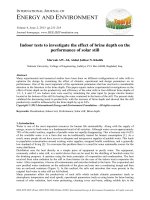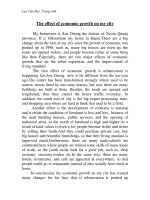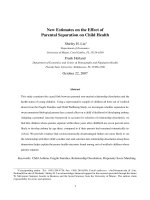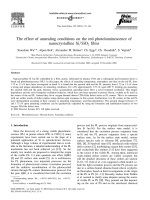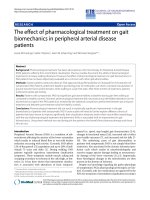The effect of fractional derivative on photo-thermoelastic interaction in an infinite semiconducting medium with a cylindrical hole
Bạn đang xem bản rút gọn của tài liệu. Xem và tải ngay bản đầy đủ của tài liệu tại đây (488.88 KB, 10 trang )
Engineering Solid Mechanics 6 (2018) 275-284
Contents lists available at GrowingScience
Engineering Solid Mechanics
homepage: www.GrowingScience.com/esm
The effect of fractional derivative on photo-thermoelastic interaction in an infinite semiconducting
medium with a cylindrical hole
Ibrahim A. Abbasa,b, Faris S. Alzahranib and F. Bertoc*
a
Department of mathematics, Faculty of Science, Sohag University, Sohag, Egypt
Nonlinear Analysis and Applied Mathematics Research Group (NAAM), Department of Mathematics, King Abdulaziz University, Jeddah, Saudi Arabia
c
NTNU, Department of Engineering Design and Materials, Richard Birkelands vei 2b, 7491 Trondheim, Norway
b
A R T I C L EI N F O
Article history:
Received 22 December, 2017
Accepted 23 April 2018
Available online
23 April 2018
Keywords:
Fractional calculus
Relaxation time
Laplace transform
A semiconducting material
Cylindrical cavity
ABSTRACT
In the present paper, the theory of generalized photo-thermoelasticity under fractional order
derivative was used to study the coupled of thermal, plasma, and elastic waves on unbounded
semiconductor medium with a cylindrical hole during the photo-thermoelastic process. The
bounding surface of the cavity was traction free and loaded thermally by exponentially
decaying pulse boundary heat flux. The medium was considered to be a semiconductor
medium homogeneous, and isotropic. In addition, the elastic and thermal properties were
considered without neglecting the coupling between the waves due to thermal, plasma and
elastic conditions. Laplace transform techniques were used to obtain the exact solution of the
problem in the transformed domain by the eigenvalue approach and the inversion of Laplace
transforms were carried out numerically. The results were displayed graphically to estimate
the effect of the thermal relaxation time and the fractional order parameters on the plasma,
thermal and elastic waves.
© 2018 Growing Science Ltd. All rights reserved.
Nomenclature
the medium density
the thermal relaxation time
the equilibrium carrier concentration
the reference temperature
the displacement components
the stress components,
the coefficient of linear thermal expansion
the thermal conductivity
the carrier diffusion coefficient
the excitation energy
the semiconducting energy gap
the photogenerated carrier lifetime
the coupling parameter of thermal activation
the stress components
the specific heat at a constant strain
the time
the position vector.
© 2018 Growing Science Ltd. All rights reserved.
doi: 10.5267/j.esm.2018.4.001
the Lame's constants
the electronic deformation coefficient
* Corresponding author.
E-mail addresses: (F. Berto)
,
276
1. Introduction
During the last twenty-five years, great efforts have been carried out to investigate the structure of
microelectronic and semiconductors through the technology of Photoacoustic (PA) and photothermal
(PT). Both the PA and PT technology are considered as insignia modes which are highly sensitive to
photoexcited carrier dynamics (Mandelis, 1987; Almond & Patel 1996). The absorption Laser beam
with modulated intensity leads to the generation photo carriers namely electron-hole pairs. The carrierdiffusion wave or plasma wave plays a dominant role in the experiments of PA and PT for most
semiconductors (Mandelis & Hess, 2000). Both the thermal and elastic waves produced as a
contribution of the plasma waves depth-dependence that generates the periodic heat and mechanically
vacillations. Thermoelastic (TE) mechanization of the elastic wave generation can be interpreted as a
result of the propagation of elastic vacillations towards the material surface due to the thermal waves
in that material. This mechanism (TE) depends on the generated heat in the material which may
generate an elastic wave due to thermal expansion and bend that, in turn, produces a quantity of heat
corresponding also to thermoelastic coupling. The electronic distortion (ED) was defined as a periodic
elastic deformation in the material due to photoexcited carriers.
Many existing models of physical processes have been modified successfully by using the fractional
calculus. We can say that the whole of integral theories and fractional derivatives was created in the
last half of the last century. Various approaches and definitions of fractional derivatives have become
the main object of numerous studies. Fractional order of weak, normal and strong heat conductivity
under generalized thermoelastic theory was established by Youssef (Youssef, 2010; Youssef & AlLehaibi, 2010) who developed the corresponding variational theorem. The theory was then used to
solve the problem of thermal shock in two dimensions using Laplace and Fourier transforms (Youssef,
2012). Based on a Taylor expansion of the order of time-fraction, a new model of fractional heat
equation was established by Ezzatt and Karamany (Ezzat, 2011; Ezzat & El-Karamany 2011a,b). Also,
Sherief et al. (2010) used the form of the law of heat conduction to depict a new model. Due to a thermal
source, the effect of fractional order parameter on a deformation in a thermoelastic plane was studied
by Kumar et al. (2013). Sherief and Abd El-Latief (2013) investigated the effect of the fractional order
parameter and the variable thermal conductivity on a thermoelastic half-space. In the Laplace domain,
the approach of eigenvalue gives an exact solution without any restrictions on the actual physical
quantity assumption. Recently, Abbas (2014a,b, 2015a,b) investigated the fractional order effects on
thermoelastic problems by using eigenvalues approach.
Understanding of transport phenomena is solid through the development spatially resolved in situ
probes has recently received a great attention. In the present work the measuring of transport processes
based on the principle of optical beam deflection through a photo-thermal approach is carried out. It
can be considered as an expansion of the photo-thermal deflection technique. Such a technique is
characterized by the fact that it is contactless and directly yields the parameters of the electronic and
thermal transport at the semiconductor surface or at the interface and within the inner bulk of a
semiconductor. Pure silicon is intrinsic semiconducting and is used in wide range of semiconducting
industry, for example, the monocrystalline Si is used to produce silicon wafers. In general, the
conduction in semiconductor (pure Si) is not the same experienced in metals. Both the electrons and
holes are responsible of the conduction value in semiconductors as well as the electrons that may be
released from atoms due to the heating of the material. Therefore electric resistance for semiconductor
decreases with increasing values of the temperature. The structures of the thermal, elastic and plasma
fields in one dimension was analyzed experimentally and theoretically by some researchers (Todorović,
2003a,b; Song et al., 2008). The effects of thermoelastic and electronic deformations in semiconductors
without considering the coupled system of the equations of thermal, elastic and plasma have been
studied in the past (McDonald and Wetsel 1978, Jackson and Amer 1980, Stearns and Kino 1985).
Opsal and Rosencwaig (1985) introduced their research on semiconducting material based on the
results shown by Rosencwaig et al. (1983). Abbas (2016) studied a dual phase lag model on
photothermal interaction in an unbounded semiconductor medium with a cylindrical cavity. Hobiny
I. A. Abbas et al. / Engineering Solid Mechanics 6 (2018)
277
and Abbas (2017) investigated the photothermal waves in an infinite semiconducting medium with a
cylindrical cavity.
The present paper is an attempt to get a new picture of photothermoelastic theory with one relaxation
time using the fractional calculus theory. Based on the fractional order theory, the photo-thermo-elastic
interaction in an infinite semiconducting material containing a cylindrical hole is investigated herein.
By using the eigenvalue approach and Laplace transform, the governing non-homogeneous equations
are processed using a proper analytical-numerical technique. From the obtained results, the physical
interpretation of the physical parameters involved in the problem is provided in this study. The
numerical solutions are carried out by considering a silicon-like semiconducting medium and the results
are verified numerically and are shown graphically in detail.
2. Basic equations
The theoretical analysis of the transport processes in a semiconductor material involves in the study
coupled elastic, thermal and plasma waves simultaneously. A homogeneous semiconducting material
is considered in the present work. The main physical quantities involved in the problem are the
distribution of the temperature
, , the density of carriers
, and the components of elastic
, . For an isotropic, elastic and homogeneous semiconductor the governing
displacement
equations of motion, plasma and heat conduction under fractional order theory can be described as
follows according to previous researches (Lord & Shulman, 1967; Todorović, 2003; Todorović, 2005;
El-Karamany & Ezzat 2011a,b):
,
,
,
(1)
Θ, ,
,
(2)
,
,
Θ,
,
1
,0
(3)
1.
The stress-strain relations can be then expressed as
,
,
Θ
,
where
, Θ
(Mandelis et al. 1997).
3
,
(4)
,
2
3
2
,
and
By taking into consideration the above definition it is possible to write:
,
,0 ,
,
,
,
,
→ 0,
0
1,
,
(5)
1,
where
is the fraction of Riemann-Liouville integral introduced as a natural generalization of the
well-known integral
, that can be written in the form of convolution type:
,
,
,
0,
(6)
In Eq. (6) Γ
is the Gamma function and
, is a Lebesgue’s integrable function. In the case
, is absolutely continuous, then it is possible to write
lim
→
,
,
,
(7)
278
The whole spectrum of local heat conduction is described through the standard heat conduction to
ballistic thermal conduction as shown in Eq. (5). The different values of fractional parameter 0<α≤1
cover two types of conductivity, α=1 for normal conductivity and 0<α<1 for low conductivity. Let us
consider a homogeneous isotropic infinite semiconducting medium containing a cylindrical hole. Its
state can be expressed in terms of the space variable and the time which occupying the region
∞. The cylindrical coordinates , , are taken with z-axis aligned along the cylinder axis. Due
to symmetry involved in the problem, only the radial displacement
, is different from zero.
Therefore Eqs. (1-4) can be expressed according to the following forms:
2
(8)
,
(9)
Θ,
1
(10)
,
2
Θ,
(11)
2
Θ.
(12)
3. Application
The initial conditions are assumed homogeneous and can be written as follows,
,
Θ ,0
0,
,
,0
0,
,
,0
(13)
0.
The traction free on the internal surface of cavity leads to the following condition
,
0.
(14)
The inner surface of the cavity
(Zenkour & Abouelregal 2015).
is subjected to a heat flux with exponentially decaying pulse
(15)
,
,
In Eq. (15) is the pulse heat flux characteristic time and is a constant. During recombination
and transport processes (surface and bulk) of the photogenerated carriers at the inner surface of cavity,
the boundary condition of the density of carrier may be exepresed according to the following
expression:
,
,
(16)
,
In Eq. (16)
is the velocity of recombination on the inner surface of hole. It is convenient to
transform the governing equations with the initial and boundary conditions into the forms of
dimensionless. Thus, the following non-dimensional quantities are introduced as
,Θ
where
,
and
,
,
,
,
,
,
, ,
,
, ,
,
,
,
(17)
.
In terms of these non-dimensional form of variables in Eq. (17), Eqs. (8-16) can be re-converted in
the following form (for convenience the primes has been dropped)
,
(18)
I. A. Abbas et al. / Engineering Solid Mechanics 6 (2018)
279
(19)
Θ,
1
(20)
,
Θ,
(21)
Θ,
(22)
(23)
,
,
,
,
,
(24)
,
0,
(25)
,
where
,
,
,
,
Let us define the transformation of Laplace for a function Φ ,
,
,
.
by
(26)
Φ ,
Φ ,
Φ ,
,
0.
Eqs. (18-25) by using the initial conditions (13) can be rewritten as follows
(27)
,
(28)
Θ,
1
,
,
,
,
Θ
(29)
,
Θ,
(30)
Θ,
(31)
,
(32)
,
(33)
0,
(34)
Differentiating Eq. (28) and Eq. (29) with respect to and using in combination Eq. (27), it is possible
to obtain the following expressions:
(35)
,
(36)
,
1
1
where
,
(37)
. Now, it is possible to solve the coupled differential Eqs (35), (36) and (37)
by the eigenvalue approach proposed (Das et al., 1997; Abbas 2014a,b,c,d2015a,b,c). From Eqs. (3537), the vector-matrix can be expressed in the following form
(38)
,
where
, V
and B
0
,
280
,
with
,
,
,
,
,
1
.
,
has its characteristic equation which is as follows
The matrix
(39)
0,
The eigenvalues of matrix are the three roots of Eq. (39) which are named here
can be calculated as:
the corresponding eigenvector
, ,
,
,
The solution of Eq. (38) which is bounded as
∑
V ,
,
,
. Thus,
(40)
.
→ ∞ can be written as
(41)
,
In Eq. (41)
, is the modified of Bessel’s function of order one, , and are
constants that can be calculated by using the problem boundary conditions. Hence, the field variables
have the solutions with respect to and in the forms:
∑
,
(42)
,
,
∑
,
(43)
,
∑
,
(44)
,
∑
,
∑
(45)
,
(46)
.
4. Numerical inversions and discussions of the results
For the general solution of temperature, density of carrier, displacement, and stress distribution, a
numerical inversion method was adopted based on Stehfest’s derivation (Stehfest 1970). In this
method, the inverse
, of the Laplace transform ̅ , is approximated by the relation
∑
,
where
,
(47)
,
is given by the following equation:
1
,
∑
!
! !
!
(48)
.
!
Now, we consider a numerical example for the computational purpose, silicon (Si) like material has
been considered. The main material constants are taken from a recent and update reference (Song et al.
2014):
2330
9 10
3 10
300 ,
,
,
,
2
5.46 10
,
2
2.5 10
,
5 10
,
10
,
,
3.64 10
,
695
1.11
,
0.2
.
,
,
I. A. Abbas et al. / Engineering Solid Mechanics 6 (2018)
281
The numerical techniques, described above, have been used for the variations of the carrier
density , the displacement , the temperature , the radial and hoop stresses
,
with respect to
r-direction in the context of generalized photothermal theory with a relaxation time under a fractional
order derivative. By using the relationship between the variable and its non-dimensional form, here all
the variables are expressed in the dimensional forms and displayed graphically as in Figs. 1-10. The
calculations were performed for the time
4.4470 .
From Fig. 1 and Fig. 6, the density of carrier have their maximum values on the surface of the hole
0.3
and decreases with the radial distance up to near the equilibrium carrier
. Fig. 2 and Fig. 7 display the variation of temperature
concentration
10
10
along the radial distance . It can be observed that starting from the heights values on the surface of
cavity then the value decreases gradually by increasing the radial distance . This happens in the
proximity of the reference temperature
300 ° beyond a wave front for the generalized photothermal model, which satisfies the theoretical boundary conditions of the problem. The radial
displacement varies as a function of as shown in Fig. 3 and Fig. 8. It is noticed that the displacement
attains a maximum negative value then it increases gradually up to a peak value in a particular location
proximately close to the surface and then continuously decreases to zero. Fig. 4 and Fig. 9 show the
variation of radial stress with respect to . It can be observed that the radial stress, always starts from
zero and drops to zero to obey the boundary conditions. The variation of hoop stress along the radial
distance was shown in Fig. 5 and Fig. 10. It is noticed that the hoop stress attains a maximum negative
values and then continuously increases to zero.
420
5
α = 0.1
α = 0.5
α = 1.0
4.5
α = 0.1
α = 0.5
α = 1.0
400
3.5
380
3
°
T (K )
n x 103 (μm−3)
4
2.5
2
360
340
1.5
1
320
0.5
0.03
0.04
0.05
0.06
0.07
0.08
0.09
0.1
300
0.03
0.04
0.05
0.06
0.07
0.08
0.09
0.1
r (μm)
r (μm)
Fig. 1. The variation of carrier density with Fig. 2. The variation of temperature with distance
distance for different values of
for different values of
0.2
1
α = 0.1
α = 0.5
α = 1.0
−2
0
0
−0.2
σrr (dyne μm )
u x 10−6 (μm)
0.5
−0.5
−1
−0.4
−0.6
−0.8
−1
−1.5
−1.2
−2
−1.4
−2.5
0.03
−1.6
0.03
0.04
0.05
0.06
0.07
0.08
0.09
0.1
r (μm)
Fig. 3. The variation of displacement with
distance for different values of
α = 0.1
α = 0.5
α = 1.0
0.04
0.05
0.06
0.07
0.08
0.09
0.1
r (μm)
Fig. 4. The variation of radial stress with
distance for different values of
282
0
5
−2
n x 103 (μm−3)
θθ
(dyne μm−2)
−1
σ
τ = 0.0 ps
4.5
−3
−4
−5
−7
0.03
0.04
0.05
0.06
0.07
0.08
0.09
τ = 0.1482 ps
3.5
τo = 0.7412 ps
3
τo = 1.4823 ps
o
2.5
2
1.5
α = 0.1
α = 0.5
α = 1.0
−6
o
4
1
0.5
0.1
0.03
0.04
0.05
Fig. 5. The variation of hoop stress with
distance for different values of
0.08
0.09
0.1
1
τo = 0.0 ps
400
0.5
τ = 0.1482 ps
o
0
(μm)
τo = 0.7412 ps
380
τ = 1.4823 ps
o
−0.5
−6
360
u x 10
°
0.07
Fig. 6. The carrier density distribution for
different values of relaxation time
420
T (K )
0.06
r (μm)
r (μm)
340
320
−1
τ = 0.0 ps
−1.5
o
τ = 0.1482 ps
o
−2
300
τ = 0.7412 ps
o
−2.5
τ = 1.4823 ps
o
280
0.03
0.04
0.05
0.06
0.07
0.08
0.09
−3
0.03
0.1
0.04
0.05
Fig. 7. The temperature distribution for different
values of relaxation time
0.09
0.1
values of relaxation time
1
0
−0.2
−1
τ = 0.0 ps
(dyne μm−2)
0
τ = 0.1482 ps
σ
−0.4
−0.6
−0.8
o
−1
o
−1.2
τo = 0.7412 ps
−1.4
τo = 1.4823 ps
0.04
0.05
0.06
0.07
0.08
0.09
−2
−3
θθ
rr
0.08
Fig. 8. The displacement distribution for different
0.2
σ (dyne μm−2)
0.07
r (μm)
r (μm)
−1.6
0.03
0.06
−4
τo = 0.0 ps
−5
τo = 0.1482 ps
τ = 0.7412 ps
o
−6
0.1
r (μm)
Fig. 9. The radial stress distribution for different
values of relaxation time
−7
0.03
τo = 1.4823 ps
0.04
0.05
0.06
0.07
0.08
0.09
0.1
r (μm)
Fig. 10. The hoop stress distribution for
different values of relaxation time
From the results, Figs. 1-5 show the variation of all physical quantities with respect to the radial
distance for different values of the fractional order parameter α when
0.1432 . It can be
observed that the dotted line refer to the normal conductivity while the solid and dashed lines refer to
the low conductivity. From these results, the fractional parameter α has a significant effect on all the
physical quantities. In the case of
0.5, the effect of thermal relaxation time on the variation of all
variables is depicted in Figs. 6-10. The results allow depicting the differences by using the coupled
photothermoelastic theory and the generalized photothermoelastic theory for a specific value of the
relaxation time.
I. A. Abbas et al. / Engineering Solid Mechanics 6 (2018)
283
5. Conclusion
In the present work, the effects of thermal relaxation time and fractional order parameters on the
plasma, thermal, and elastic waves in semiconductor media with cylindrical holes has been studied.
Analytical expressions for temperature, displacement, density of carrier, radial stress and hoop stress
in the medium have been accurately derived. Results carried out in this paper can be used to design
various semiconductor elements during the presence of coupled thermal, elastic and plasma and waves
and can also be applied to other fields like in the material science, physical engineering. Moreover these
findings can help the designers of new materials to meet special engineering requirements in very
specific service conditions.
References
Abbas, I. A. (2014a). Eigenvalue approach for an unbounded medium with a spherical cavity based
upon two-temperature generalized thermoelastic theory. Journal of Mechanical Science and
Technology, 28(10), 4193-4198.
Abbas, I. A. (2014b). Eigenvalue approach in a three-dimensional generalized thermoelastic
interactions with temperature-dependent material properties. Computers & Mathematics with
Applications, 68(12), 2036-2056.
Abbas, I. A. (2014c). A problem on functional graded material under fractional order theory of
thermoelasticity. Theoretical and Applied Fracture Mechanics, 74, 18-22.
Abbas, I. A. (2014d). The effects of relaxation times and a moving heat source on a two-temperature
generalized thermoelastic thin slim strip. Canadian Journal of Physics, 93(5), 585-590.
Abbas, I. A. (2015a). Eigenvalue approach on fractional order theory of thermoelastic diffusion
problem for an infinite elastic medium with a spherical cavity. Applied Mathematical Modelling,
39(20), 6196-6206.
Abbas, I. A. (2015b). A dual phase lag model on thermoelastic interaction in an infinite fiber-reinforced
anisotropic medium with a circular hole. Mechanics Based Design of Structures and Machines,
43(4), 501-513.
Abbas, I. A. (2015c). Eigenvalue approach to fractional order generalized magneto-thermoelastic
medium subjected to moving heat source. Journal of Magnetism and Magnetic Materials, 377, 452459.
Abbas, I. A. (2016). A dual phase lag model on photothermal interaction in an unbounded
semiconductor medium with cylindrical cavity. International Journal of Computational Materials
Science and Engineering, 5(03), 1650016.
Almond, D. P., & Patel, P. (1996). Photothermal science and techniques (Vol. 10). Springer Science
& Business Media.
Das, N. C., Lahiri, A., & Giri, R. R. (1997). Eigenvalue approach to generalized thermoelasticity.
Indian Journal of Pure and Applied Mathematics, 28, 1573-1594.
El-Karamany, A. S., & Ezzat, M. A. (2011). On fractional thermoelasticity. Mathematics and
Mechanics of Solids, 16(3), 334-346.
Ezzat, M. A. (2011a). Magneto-thermoelasticity with thermoelectric properties and fractional
derivative heat transfer. Physica B: Condensed Matter, 406(1), 30-35.
Ezzat, M. A. (2011b). Theory of fractional order in generalized thermoelectric MHD. Applied
Mathematical Modelling, 35(10), 4965-4978.
Ezzat, M. A., & El-Karamany, A. S. (2011a). Fractional order theory of a perfect conducting
thermoelastic medium. Canadian Journal of Physics, 89(3), 311-318.
Ezzat, M. A., & El Karamany, A. S. (2011b). Theory of fractional order in electro-thermoelasticity.
European Journal of Mechanics-A/Solids, 30(4), 491-500.
Hobiny, A. D., & Abbas, I. A. (2017). A study on photothermal waves in an unbounded semiconductor
medium with cylindrical cavity. Mechanics of Time-Dependent Materials, 21(1), 61-72.
Jackson, W., & Amer, N. M. (1980). Piezoelectric photoacoustic detection: theory and experiment.
Journal of Applied Physics, 51(6), 3343-3353.
284
Kumar, R., Gupta, V., & Abbas, I. A. (2013). Plane deformation due to thermal source in fractional
order thermoelastic media. Journal of computational and theoretical nanoscience, 10(10), 25202525.
Lord, H. W., & Shulman, Y. (1967). A generalized dynamical theory of thermoelasticity. Journal of
the Mechanics and Physics of Solids, 15(5), 299-309.
Mandelis, A. (1987). Photoacoustic and thermal wave phenomena in semiconductors.
Mandelis, A., & Hess, P. (2000). Semiconductors and electronic materials (Vol. 4). Spie Press.
Mandelis, A., Nestoros, M., & Christofides, C. (1997). Thermoelectronic-wave coupling in laser
photothermal theory of semiconductors at elevated temperatures. Optical Engineering, 36(2), 459469.
McDonald, F. A., & Wetsel Jr, G. C. (1978). Generalized theory of the photoacoustic effect. Journal
of Applied Physics, 49(4), 2313-2322.
Opsal, J., & Rosencwaig, A. (1985). Thermal and plasma wave depth profiling in silicon. Applied
Physics Letters, 47(5), 498-500.
Rosencwaig, A., Opsal, J., & Willenborg, D. L. (1983). Thin-film thickness measurements with thermal
waves. Le Journal de Physique Colloques, 44(C6), C6-483.
Sherief, H., & El-Latief, A. A. (2013). Effect of variable thermal conductivity on a half-space under
the fractional order theory of thermoelasticity. International Journal of Mechanical Sciences, 74,
185-189.
Sherief, H. H., El-Sayed, A. M. A., & El-Latief, A. A. (2010). Fractional order theory of
thermoelasticity. International Journal of Solids and structures, 47(2), 269-275.
Song, Y., Cretin, B., Todorovic, D. M., & Vairac, P. (2008). Study of photothermal vibrations of
semiconductor cantilevers near the resonant frequency. Journal of Physics D: Applied Physics,
41(15), 155106.
Song, Y., Todorovic, D. M., Cretin, B., Vairac, P., Xu, J., & Bai, J. (2014). Bending of semiconducting
cantilevers under photothermal excitation. International Journal of Thermophysics, 35(2), 305-319.
Stearns, R. G., & Kino, G. S. (1985). Effect of electronic strain on photoacoustic generation in silicon.
Applied Physics Letters, 47(10), 1048-1050.
Stehfest, H. (1970). Algorithm 368: Numerical inversion of Laplace transforms [D5]. Communications
of the ACM, 13(1), 47-49.
Todorović, D. M. (2003a). Photothermal and electronic elastic effects in microelectromechanical
structures. Review of Scientific Instruments, 74(1), 578-581.
Todorović, D. M. (2003b). Plasma, thermal, and elastic waves in semiconductors. Review of Scientific
Instruments, 74(1), 582-585.
Todorović, D. M. (2005, June). Plasmaelastic and thermoelastic waves in semiconductors. In Journal
de Physique IV (Proceedings) (Vol. 125, pp. 551-555). EDP sciences.
Youssef, H. M. (2010). Theory of fractional order generalized thermoelasticity. Journal of Heat
Transfer, 132(6), 061301.
Youssef, H. M. (2012). Two-dimensional thermal shock problem of fractional order generalized
thermoelasticity. Acta Mechanica, 223(6), 1219-1231.
Youssef, H. M., & Al-Lehaibi, E. A. (2010). Variational principle of fractional order generalized
thermoelasticity. Applied Mathematics Letters, 23(10), 1183-1187.
Zenkour, A. M., & Abouelregal, A. E. (2015). Effect of temperature dependency on constrained
orthotropic unbounded body with a cylindrical cavity due to pulse heat flux. Journal of Thermal
Science and Technology, 10(1), JTST0019-JTST0019.
© 2018 by the authors; licensee Growing Science, Canada. This is an open access article
distributed under the terms and conditions of the Creative Commons Attribution (CC-BY)
license ( />

